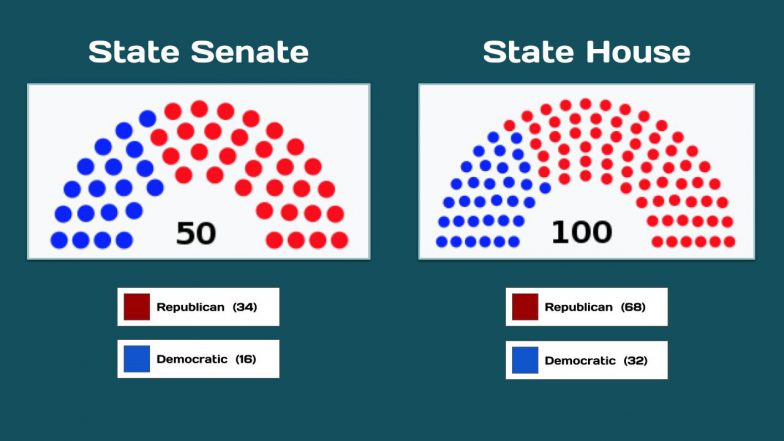Summary
The Montana State Legislature is the state legislature of the U.S. state of Montana. It is composed of the 100-member Montana House of Representatives and the 50-member Montana Senate.
The Montana Constitution dictates that the legislature meet in regular session for no longer than 90 days in each odd-numbered year.[1] The primary work of the legislature is to pass a balanced biennial budget which must then be approved by the Governor. If the Governor vetoes a bill, the legislature may override the veto by a two-thirds vote.
The Montana State Legislature meets in the state capitol in Helena.
Source: Wikipedia
OnAir Post: MT Legislature
News
The Montana Supreme Court announced on Tuesday it will issue a final ruling on the Legislature’s subpoenas, rejecting GOP lawmakers’ request to dismiss the case.
The state high court is moving forward with the case because justices say the dispute over Legislative powers is a relevant issue likely to come up again.
The legal battle was prompted by GOP lawmakers who filed subpoenas for the state’s Supreme Court justices and court administrator to obtain internal communications in an unprecedented investigation into allegations of bias and misconduct among the judicial branch. Court officials reject those allegations.
Lawmakers last week withdrew their subpoenas and asked the court to dismiss the case.
However, Court Administrator Beth McLaughlin opposed that move and asked for a final ruling to determine the scope of the Legislature’s subpoena power. The court agreed.
Republican Sen. Greg Hertz says the Supreme Court has a conflict of interest in ruling on the subpoenas and is “once again abandoning normal procedure” by ruling on a withdrawn request.
The latest bills to be signed into statute, or killed, by Gov. Greg Gianforte.
The 67th Montana Legislature has concluded, but not all of the new policies passed by lawmakers have yet to clear their final hurdle: the signature of Gov. Greg Gianforte. Gianforte does have the option to veto any measures he disagrees with, or he could opt in some cases not to act at all, in which case the bill will become law after 10 days. Here’s a look at some of the major laws Gianforte has signed since the session ended. Montana Free Press will update this information.
About
Source: Wikipedia
Since the beginning of statehood for Montana, the Legislature has been split along party lines fairly consistently and evenly. Since adoption of the current state constitution in 1972, which mandated single-member legislative districts for the first time in the state’s history, the Montana Senate has been controlled by Democrats in nine sessions, and Republicans in 16 sessions. During the same period, the Montana House has been controlled by Democrats in eight sessions and Republicans in 15 sessions, with two ties. According to state law, in the instance of a tie, control goes to the party of the sitting governor. The 67th Legislature (2021–2022) is controlled by the Republican Party with the House having 67 Republican members and 33 Democratic members, and the Senate having 31 Republican members and 19 Democratic members.
Members are limited to serving no more than eight years in either chamber, but the term limit is consecutive, not lifetime.
Wikipedia
Contents
The Montana State Legislature is the state legislature of the U.S. state of Montana. It is composed of the 100-member Montana House of Representatives and the 50-member Montana Senate.[1]
The Montana Constitution dictates that the legislature meet in regular session for no longer than 90 days in each odd-numbered year.[1] The primary work of the legislature is to pass a balanced biennial budget which must then be approved by the governor. If the governor vetoes a bill, the legislature may override the veto by a two-thirds vote.[1]
Since the beginning of statehood for Montana, the Legislature has been split along party lines fairly consistently and evenly. Since adoption of the current state constitution in 1972, which mandated single-member legislative districts for the first time in the state's history, the Montana Senate has been controlled by Democrats in 9 sessions and Republicans in 16 sessions.[2] During the same period, the Montana House has been controlled by Democrats in 8 sessions and Republicans in 15 sessions, with two ties. According to state law, in the instance of a tie, control goes to the party of the sitting governor. The 67th Legislature (2021–2022) was controlled by the Republican Party with the House having 67 Republican members and 33 Democratic members; the Senate has 31 Republican and 19 Democratic members.[2]
The 68th Legislature (2023-2024) is controlled by a Republican "supermajority," meaning that Republicans control two-thirds of the seats in both the House of Representatives and the Senate, allowing them to override gubernatorial vetoes and potentially pass proposals for amendments to the Montana Constitution.[3]
Members are limited to serving no more than eight years in either chamber, but the term limit is consecutive, not lifetime.[4]
Legislative districts are redrawn every ten years, after each census.[5] The new boundaries, after the 2020 census, became effective starting with the 2024 elections.[6]
The Montana State Legislature meets in the state capitol in Helena.
See also
References
- ^ a b c "Montana Legislature: Organization". Montana Legislature. Archived from the original on May 25, 2018. Retrieved September 5, 2016.
- ^ a b "Majority and Minority Party Numbers 1889 - Present". Montana Legislature.
- ^ Marino, Michael, J. (January 6, 2023). "Lawmakers Sworn In, Set Hearings for Over 4,000 Pending Bills". Yellowstone County News. p. 1. Retrieved February 14, 2023.
{{cite news}}: CS1 maint: multiple names: authors list (link) - ^ Johnson, Charles (February 24, 2015). "State Senate committee tables proposed ballot measure to end term limits". Missoulian.
- ^ "Article 5, Section 14 Districting And Apportionment". State of Montana. November 6, 1984. Retrieved December 27, 2023.
- ^ "Montana state legislative districts". Ballotpedia. Retrieved December 27, 2023.
External links
- Official Montana State Legislature Website
- Party Control in the Montana Legislature
- Montana's split-party control statute
- Maggie Smith Hathaway Collection (University of Montana Archives)



